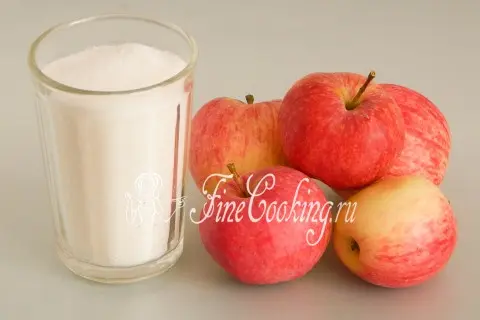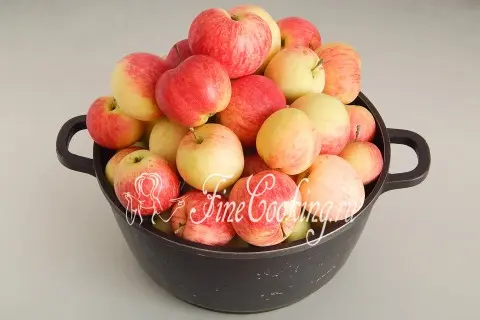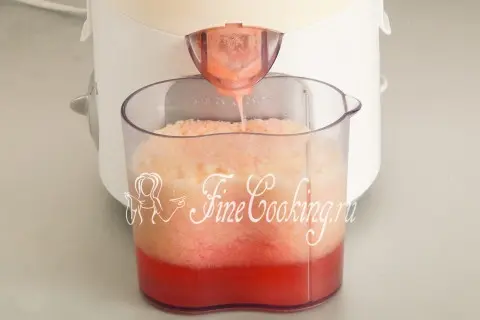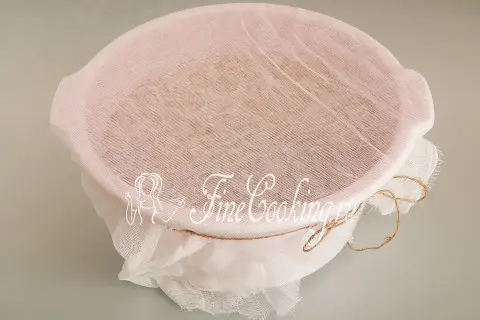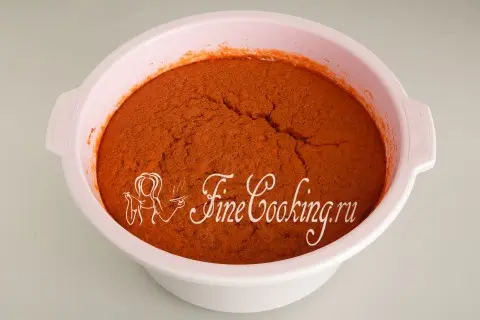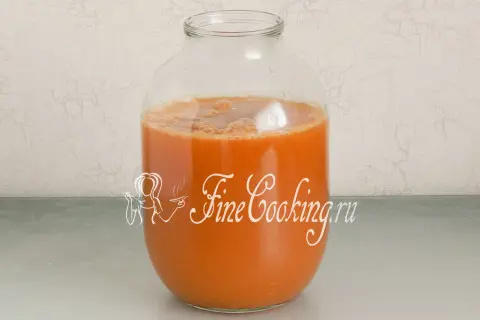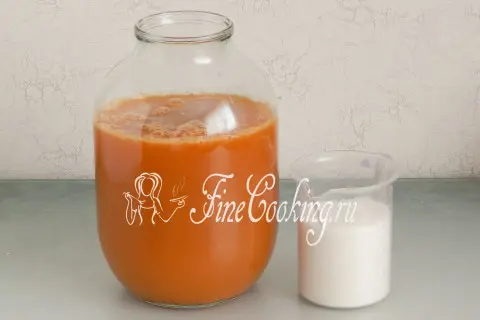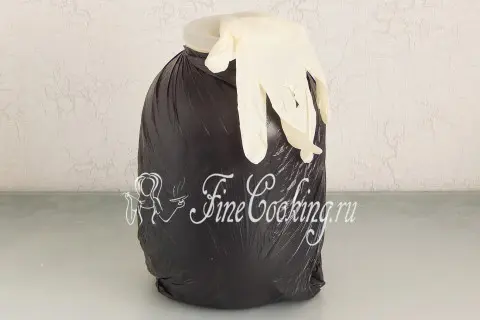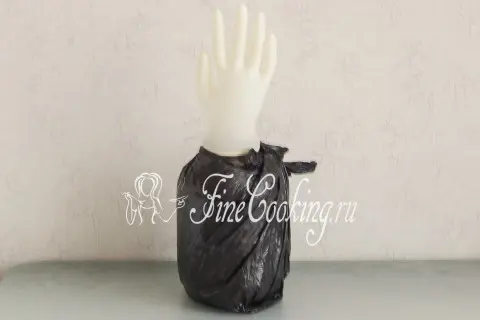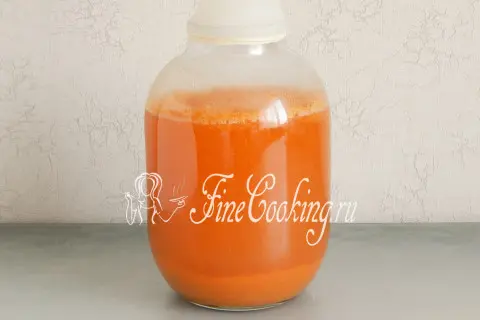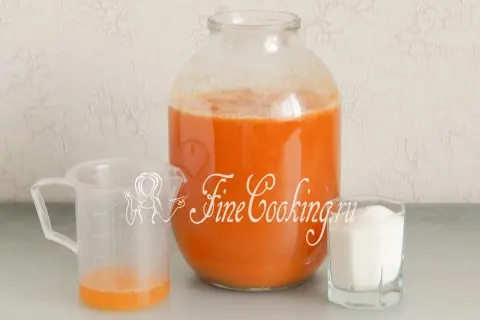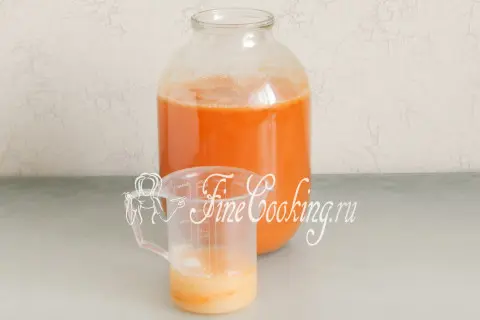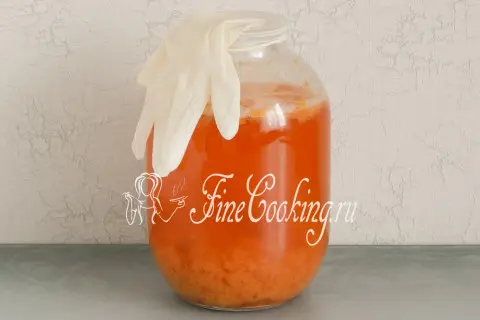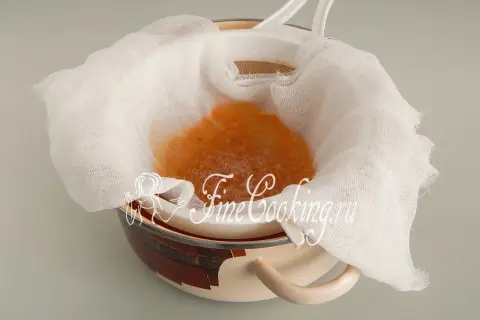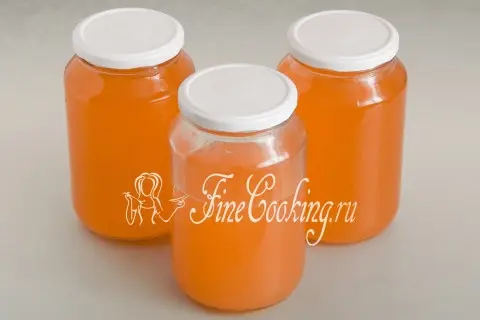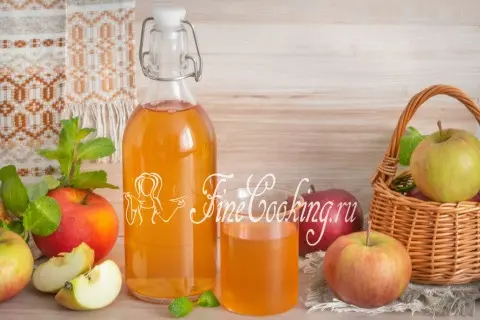Contents
- What you need to know
- How to make wine from apples: a question of raw materials
- Basic Apple Wine Recipe
- Frozen apple wine
- Apple jam wine
- Easy Apple Wine Recipe
- Wine from apples with pears
- Apple wine with rowan juice for better clarification
- Alternative Apple Wine Recipe
- Dried apple wine
- Table for compiling 100 liters of must for making 80 liters (120 bottles) of apple wine
- Homemade apple wine – step by step recipe
What you need to know
Making wine from apples – this is a very wise decision, especially if the harvest exceeded all your expectations. The main thing is not to bring the situation to the point of absurdity. In particular, on the Internet, you can stumble upon dubious advice on how to make wine from dried apples.
In fact, you will be told how to make yeast brew from apple dust diluted with water. In our opinion, you will win much more if you do not succumb to such provocations, but use the available dried fruits to make fragrant and tasty uzvar.
But, to complete the picture, Vzboltay still offers to get acquainted with this recipe.
How to make wine from apples: a question of raw materials
The most difficult and crucial moment in our case is the issue of selecting wine material and determining the amount of sugar. In principle, all known categories of apple varieties are suitable for our purposes: sour, sweet and sour, sweet and bitter (they are also tart). However, there are subtleties and preferences here. So, to get a light table drink, it is desirable to use sweet and sour fruits of autumn ripening. If we are talking about strong table, dessert and liqueur wines, we should focus on sour and sweet and sour winter varieties; for example, put wine from Antonovka apples.
However, aerobatics in apple winemaking is the blending of different varieties. At the same time, to facilitate the task, you can use the classic proportions, proven for centuries:
- 37,5% sweet, 37,5% bitter, 25% sour;
- 40% sweet, 40% bitter, 20% sour;
- 25% sweet, 25% bitter, 50% sour;
- 25% sweet, 75% bitter;
- 66% sweet, 34% bitter;
- 66% moderately bitter, 34% sweet.
When preparing raw materials, the degree of fruit ripening should also be taken into account. So, if we are talking about summer varieties, then they can be put into action immediately after harvest. Autumn varieties need to be kept in a dark place for 4-7 days for full ripening. Winter apples, on the other hand, need to rest in a dry cellar for 3-4 weeks to reach final ripeness.
An equally important issue is the proportional calculation of sugar and apple juice. It depends both on the level of acidity of the fruit, and on the type of drink planned at the exit. Experienced experts in horticultural winemaking recommend adhering to the following ratios:
- Light table wines – 150-200 g of sugar per 1 liter of juice;
- Strong table wines – 200-250 g of sugar per 1 liter of juice;
- Dessert wines – 300-350 g of sugar per 1 liter of juice;
- Liquor wines – 400 g of sugar per 1 liter of juice.
If your crop consists mainly of sweet fruits, then in order to avoid too much sugar content (and, as you know, it should not exceed 20%), it is necessary to increase the acidity of the future wine by adding 10-20% blackthorn or rowan juice to it.
Basic Apple Wine Recipe
- Rub the apples thoroughly, but in no case wash (without preserving the wild yeast living on the peel, all your efforts will be doomed to failure).
- Then, rid the fruit of the core, cuttings, seeds, rot, wormholes, mold and diseased areas.
- Using a blender or meat grinder, get a mushy mass. Squeeze juice out of it using ordinary gauze or a special press. Send the result to a glass or enameled container with a wide neck.
- Leave the container with the future wort for 3 days in a dark, warm place, covering it with gauze. At the same time, do not forget to stir the contents of the vessel with a wooden spatula 3-4 times a day. After the specified period, remove the cap formed from the pulp with a colander, leaving only a small layer of pulp on the surface, whose thickness should not exceed 0,5 cm. If active fermentation has not begun by the specified time, you can add a little sugar to the substance (no more than 20 % of total) to activate the yeast and extend the pre-fermentation process for a couple more days.
- Combine the juice prepared in this way with the total mass of sugar (choose the proportion), stirring it until completely dissolved.
- Pour the resulting wort into a dry glass container, filling it to a maximum of 4/5, and leave for 30-45 days in a warm, dark place under a water seal.
- At the end of fermentation, let the wort settle for a week, then remove it from the sediment and pour it into a clean, dry glass vessel for further maturation.
Attention! If fermentation is not completed 55 days after the start of the process, the liquid should be carefully drained from the sediment and transferred to a clean vessel, covered with a lid with a water seal. Otherwise, you risk getting an unusable bitter drink.
- Before being sent for aging, young wine can be sweetened by adding a certain amount of sugar to it. In this case, the drink must be kept for a few more days to clear the conscience under a water seal. There is also another possibility: add 5-15% good vodka or a forty-degree water-alcohol solution, thereby obtaining fortified wine from apples.
Before sealing the container with the drink being sent for maturation, make sure it is full to the eyeballs. This precaution is necessary so that the wine does not sour from contact with air. Otherwise, you will have to creak your heart to process it into apple cider vinegar. The aging period of the drink ranges from 2 to 4 months, but it will be better if you endure up to six months. Wine maturation takes place in a cool dark room at a temperature of 8-15°C. After that, the drink, if necessary, is once again removed from the sediment, bottled and consumed.
Frozen apple wine
In principle, if necessary, a quite tolerable drink can be prepared from frozen apples. However, it should be borne in mind that as a result of freezing, the fruits will be less juicy, and in addition, they will lose wild yeast, which is so valuable in this case. In this regard, some changes will have to be made to the basic recipe.
First: apple juice, or rather, applesauce obtained from thawed apples, will need to be diluted with water in a 1: 1 ratio.
Second: at the pre-fermentation stage, add a handful of unwashed raisins to the wort (200 g per 1 liter of liquid).
And thirdly: reduce the amount of added sugar to 100-150 g per 1 liter of wort.
Apple jam wine
If the apple jam prepared for the winter is candied or fermented (but not sour) and the toad presses to throw it away, try turning it into wine.
Method of preparation
- Dilute the jam with water heated to a temperature of 20-25 ° C in a ratio of 1: 1.
- Further, in the case of a candied product, add unwashed raisins at the rate of 15-20 g per 1 liter of the substance; in the case of a fermented version, put granulated sugar instead of raisins in a proportion of 150-200 g per 1 liter of must.
- Cover the container with the resulting substance with a lid with a water seal, then follow the basic recipe. At the same time, pay special attention to removing the wine from the sediment, replacing it with a full filtration if necessary.
Well, and, of course, do not expect a stunning result. You will get a drink, frankly, for an amateur.
Easy Apple Wine Recipe
Ingredients
- Apples – 1 kg
- Sugars – 700 g
- Water – 2 L
- Cinnamon – 1 tbsp l.
Method of preparation
- Wash the apples, cut into small pieces and pour into a container, add water and cinnamon and cook until the mass softens.
- Then rub the mass through a sieve and leave to ferment.
- After fermentation, strain and add sugar, let the wine stand and strain again.
- Pour the finished homemade wine into bottles and store in a cool place.
Wine from apples with pears
Ingredients
- Apple juice – 10 l
- Pear juice – 1,5-2 cups
- Sugar – 2 kg
Method of preparation
- Grind a mixture of sour and sweet apples (choose a proportion), hold for 2 days, squeeze out the juice.
- Add pear juice and sugar to apple juice.
- Ready wort put on fermentation.
- After fermentation, strain and add sugar, let the wine stand and strain again.
- Bottled and aged for at least a month.
Apple wine with rowan juice for better clarification
Proportion: for 9 parts of apple juice, 1 part of rowan juice.
Ingredients
- Apple juice – 6,3 l
- Rowan juice – 0,7 l
- Sugar – 2,5 kg sugar
- Water – 1,5 L
Method of preparation
- To obtain the wort, you need to take apple (preferably from late varieties of apples) and rowan juices, add sugar and water.
- After thoroughly mixing the juices with water and dissolving the sugar, pour the wort into bottles and put on fermentation.
- Fermentation lasts 7-10 days. The result is a wine with a strength of 5-11 degrees.
If there is a desire to make the wine stronger (16 degrees), the wine must be alcoholized. For 10 liters of wine, take 0,5 liters of alcohol or 1 liter of vodka, distribute evenly among the bottles, mix thoroughly until a uniform strength of wine is obtained. Aged wine for 5 days. Then filter and bottle.
Alternative Apple Wine Recipe
Ingredients
- Apples – 1 kg
- Sugar – 1,5 kg
- Water – 4,5 L
- Cinnamon – 1 tbsp l.
- Yeast – 20 g
- Lemon – 2 pcs.
Method of preparation
- Wash the apples and cut into small slices, pour boiling water over and put the mass under the press.
- Keep under pressure for 4 days, then strain and add lemon juice, cinnamon and yeast.
- Place the container in a dark place for fermentation. When the fermentation process is over, mix the mass and stand for 2-3 days.
- Then strain again and pour into a barrel. In it, homemade wine is aged for six months, and then bottled and stored in a cool place.
Dried apple wine
Ingredients
- Dried apples of sour and sweet varieties – 1 kg
- Sugars – 100 g
- Water – 1,73 L
- Yeast (preferably wine) – 1 tsp
- Alcohol 70% – 500 ml
Method of preparation
- Take dried apples of sweet and sour varieties, put in a wooden or enamel bowl, pour hot water at 80–90 ° C and insist for a day (take 1 ml of water per 800 kg of apples).
- Then press the apples, pour the resulting liquid into a bottle, add 10% sugar syrup (for 1 liter of syrup, take 930 ml of water and 100 g of sugar) and yeast, close the bottle with a fermentation stopper and leave for fermentation.
- After 5-6 days, the wort can be alcoholized by adding 500 ml of alcohol 70 ° per 1 liter.
- Pour the mixture into a clean bottle, close and let it brew for 3-5 days.
- Then the wine is carefully removed from the sediment and left to mature in a tightly closed vessel for 6-8 months. At the same time, make one or two transfusions using a tube (depending on the amount of sediment).
- Remove the finished wine from the sediment, pour into bottles, cork and store in a cool place.
https://www.youtube.com/watch?v=C95pz2FM57Q
Table for compiling 100 liters of must for making 80 liters (120 bottles) of apple wine
NEED JUICE, OTHER MATERIALS | CIDER | DINING WINE | SWEET WINE | |||
1 | 2 | 3 | 4 | 5 | ||
1. FROM FOREST APPLES AND UNripe carrion (ACIDITY 1,5%; SUGARITY 6,0%) | ||||||
| Juice (liters) | 40,0 | 46,7 | 53,3 | 80,0 | 66,67 | 78,0 |
| Water (liters) | 53,04 | 46,6 | 35,75 | 1,9 | 12,0 | 0 |
| Sugar (kg) | 11,6 | 11,2 | 18,3 | 30,2 | 35,5 | 51,3 |
| Need fruit (kg) | 53,3 | 62,0 | 71,0 | 107,0 | 89,0 | 104,0 |
2. APPLE SOUR—SWEET HOUSEHOLD VARIETIES (ACIDITY 0,9%; SUGARITY 10%) | ||||||
| Juice (liters) | 66,7 | 78,0 | 88,8 | 84,0 | 81,0 | 64,0 |
| Water (liters) | 29,0 | 18,3 | 5,6 | 0 | 0 | 0 |
| Sugar (kg) | 7,3 | 6,2 | 12,6 | 26,6 | 31,4 | 59,4 |
| Tartaric acid (g) | 0 | 0 | 0 | 412 | 233 | 752 |
| Tannic acid (g) | 0 | 0 | 0 | 32 | 38 | 172 |
| Need apples (kg) | 89 | 104 | 118 | 112 | 108 | 85 |
3. APPLE SOUR—SWEET GOOD VARIETIES (ACIDITY 0,7%; SUGARITY 15%) | ||||||
| Juice (liters) | 85,5 | 92,8 | 95,0 | 86,0 | 84,0 | 66,0 |
| Water (liters) | 14,4 | 7,15 | 0 | 0 | 0 | 0 |
| sugar (kg) | 0,125 | 0,80 | 7,25 | 22,1 | 26,9 | 56,1 |
| Stone acid (g) | 0 | 0 | 150 | 484 | 296 | 804 |
| Tannic acid (g) | 0 | 0 | 105 | 114 | 116 | 234 |
| Need apples (kg) | 114 | 124 | 127 | 115 | 112 | 88 |
4. FROM A MIXTURE OF APPLES, SOUR, SWEET AND TARTER | ||||||
1 hour sour apple juice (L) (1,2% acid, 6,0% acid) | 16,26 | 16,26 | 15,30 | 14,03 | 13,55 | 10,7 |
4 hours sweet apple juice (l) (0,2% acid, 20% acid) | 65,04 | 65,04 | 61,2 | 56,12 | 54,2 | 42,9 |
1 hour tart apple juice (l) (acid 2,0%, acid 18,0%) | 16,26 | 16,26 | 15,30 | 14,03 | 13,55 | 10,7 |
| Sugar (kg) | 3,94 | 3,94 | 12,05 | 26,33 | 31,12 | 59,37 |
| Tartaric acid (g) | 0 | 0 | 0 | 444 | 263 | 776 |
| Tannic acid (g) | 0 | 56 | 200 | 200 | 200 | 300 |
Homemade apple wine – step by step recipe
Ingredients:
Cooking step by step:
To make homemade apple wine, we only need fresh apples and granulated sugar (these are the necessary ingredients). I will write about dishes and other devices below.
We take fresh apples – I show 5 kilograms as an example, and you use as much as you have. Do not wash apples, as there are wild yeasts on the surface. If you use scavengers (apples that have fallen off the tree), gently wipe them with a dry cloth or a new dishwashing sponge. This is if the apples are too dirty.
The first step in making homemade apple wine is getting the juice. We pass the fruits through the juicer, not forgetting to remove the cake from it from time to time.
The second stage is the settling of the juice. Pour all the apple juice with foam into a suitable container (I have a bowl of 5 liters of food plastic). You can defend the juice in any (but not aluminum) dishes with a wide mouth.
We tighten it with a piece of gauze and tie it tightly so that insects do not get inside. We leave it in this form right on the kitchen table for 3 days.
During this time, the contents of the dishes should be mixed well 2-4 times a day. The wild yeast that was on the surface of the apples will begin to work: the fruit mass will be divided into two parts – apple juice and pulp (puree-like pulp with skin). That is, 2-4 times a day, remove the gauze, mix everything and tighten it again.
On the third day, you should observe this picture. The pulp will gather on the surface of the juice with a dense cap and, if you disturb it (pick it up), you will hear a hiss and feel a characteristic sour smell with hints of alcohol. Fermentation has begun!
Carefully remove the pulp with a slotted spoon (wide spoon with holes) and transfer it to a separate bowl. If a lot of juice is taken along with the pulp, throw the whole thing on gauze for an hour. During this time, get some more apple juice, and throw away the dense pulp.
In total, from 5 kilograms of fairly juicy apples, I got 2.5 liters of fermented juice. Pour it into a clean three-liter jar – it is absolutely not necessary to sterilize it. You can use other dishes, but it is important to remember that you need to pour the juice no more than 3/4 of the volume of the vessel (foam will appear during the fermentation process).
The third stage is the addition of granulated sugar. As I wrote above, the amount of sugar when making homemade apple wine depends on the initial sweetness of the apples, as well as the desired result. I put several batches of wine at once with different amounts of sugar in order to understand which result I liked more. So, the ideal ratio of juice and sugar (for me and my husband) is 200 grams of sugar per 1 liter of juice. This is taking into account that we had sweet and sour varieties of apples (closer to sweet) and we generally love sweets. However, adding sugar to apple juice when making wine must be done in batches, not all at once. If we have 2.5 liters of juice, then we need 500 grams of sugar. To begin with, add 300 grams and mix thoroughly until it is completely dissolved.
The fourth step in making homemade apple wine is the fermentation of apple juice. To do this, you need to make a water seal or use a rubber glove. You can see an example of a water seal in the strawberry wine recipe , but in this case I just put a new rubber glove on the neck of the jar (sold in a pharmacy). Just do not forget to pierce your finger (gloves, of course) with a needle so that it does not come off later.
Additionally, you need to wrap the jar with something dark so that sunlight does not pass through. I took a regular black plastic bag. Alternatively, place the jar in a dark room. The fermentation process of homemade apple wine will last about 1.5-2 months, but it is important to understand that the cooking time depends on the room temperature.
In just a few hours, when you put on a glove, it will puff up and wave at you. In this state, apple juice will ferment in conditions of 17-25 degrees. When we had no heating, and the apartment was cold and damp, the glove fell off. I brought the jar into the kitchen (it’s always warmer there) and the process went more fun.
After 3 days, the glove will stand upright, and sediment will appear at the bottom of the jar. It’s time to add the second batch of sugar.
Pour a little (about 50 milliliters) of juice into a separate container. We take 100 grams of granulated sugar.
Mix sugar with juice so that most of the first dissolves.
Pour back into the jar, mix the contents, pull on the glove, create darkness and put on fermentation for another 3 days. Three days later, we repeat the introduction of sugar (another 100 grams), not forgetting to mix it with a small amount of juice. When all the sugar (500 grams per 2.5 liters of juice) is in the jar, do not touch the future apple wine. During the fermentation process, the glove may deflate slightly or, on the contrary, practically wave at you – this is all normal and natural.
The readiness of homemade apple wine will serve as a glove that will completely deflate and fall off. If you use a water seal, the readiness of the wine is determined by the absence of bubbles of carbon dioxide, which will stop flowing into a glass of water. In addition, a noticeable sediment forms at the bottom of the can. In fact, it is not as tall as in the photo – it was me who so inaccurately transferred the jar to the kitchen from the room where the wine was fermenting.
To prevent sediment from getting into the finished wine and get the most transparent drink, I advise you to use a dropper for transfusion (more precisely, a silicone tube). In the recipe for apple cider, I showed how to do it . But in this case, it was more convenient for me to simply strain the apple wine through cheesecloth (fold in 5 layers).
The final stage is ripening (aging). Already, homemade apple wine is ready to drink, but it tastes rather harsh. That is why prepare glass jars or bottles, which it is desirable to sterilize (as for other blanks for the winter). Pour apple wine into dry jars to the VERY top and close them hermetically (with screw caps or turnkey tins). I prepared two liter jars from this batch just like that, and left one incomplete for further tasting. You can store homemade apple wine in a dry, dark place (basement, cellar or pantry) for up to three years. Before use, I advise you to cool the wine – it tastes better in my opinion.
Fragrant, moderately sweet, light, but at the same time intoxicated (carefully there when tasting!) Apple wine made at home with your own hands is just lovely! Natasha, thank you very much for the order – I hope and believe that the recipe will come in handy. Cook to your health, delicious wine and pleasant tasting, friends!
Did you like the recipe? Share it on social networks with your friends – make their life tastier too!












